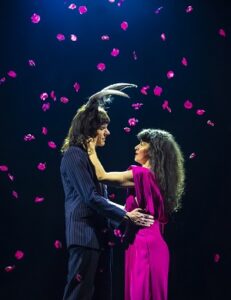Jessica Harris enjoys an unseasonal classic from the RSC.
A more electric version of A Midsummer Night’s Dream than this production by the RSC you are unlikely to see. A night-time setting provides the backdrop for the three worlds, the Athenian court where marriage is more a transaction than a matter of love, the woodland fairy realm which truly holds the power over the fate of mortals, and the domain of the clowns where amiability and chaos live side by side.
The darkness of the setting allows for an endless ethereal spectacle which signifies the presence of other realities, whether that of the fairy world or the world of dreams. Digital projections change the backdrop from monochrome to colour, signalling the shift from court to forest. Fairies hover in the form of neon spotlights. Orbs hang high above the stage, transforming in colour and texture at moments of sorcery and bewitchment. Stunning stagecraft is the centrepiece of this production under the direction of Eleanor Rhode.

Against this background, actors tend towards the physical and the comedic in their performances. Physicality is put to good effect as Hermia, in advance of their wedding, tells Lysander to lie further off, whilst the fights between the two sets of lovers, coaxed into changing their affections by magical flower juice which Puck drops into their eyes, fill the stage with movement and body language. Hermia, played by Dawn Sievewright, is a wonderfully grounded character, who uses candour and authenticity in the pursuit of her love interest, Lysander, played by Ryan Hutton. He, meanwhile, is excessive and extreme in his new-found love for Helena, and yet stays just on the right side of being overblown.
Bally Gill as Oberon captures both the lordly and the compassionate nature of the character, and makes remarkable costume and makeup changes as he discards the punk-like appearance of Oberon for the business dress of Theseus, for whom he doubles.
The cast of clowns is hilariously chaotic. Bottom, played by Matthew Baynton (familiar to many from TV comedies including Ghosts and Horrible Histories), is audacious and rambunctious. His death scene as Pyramus, thwarted lover of Thisbe, in the play performed by the clowns for the court’s wedding festivities, is taken as far possible into the absurd, as he uses a penknife to stab at points of fake blood in his costume – pure white and thoroughly tacky. Helen Monks portrays Quince as a long-suffering producer of the play within a play, Shakespeare’s humorous nod to his own profession of theatre making. Her turn as a rapper to deliver the prologue is a wonderful touch of fun.
But there are moments of over-reliance on acting which is big and brash and on the chasing of laughs. Occasionally, the worlds of court and fairies risk stealing the thunder from the clowns. At times a quieter mood might have allowed Shakespeare’s poetry to speak more clearly of the nature of true love.
It is left to Puck to bring in the poetry, and to focus on the grace of Shakespeare’s words. Premi Tamang stepped into this role on press night, due to the indisposition of Rosie Sheehy. Her performance had a delicacy of delivery both in speech and movement, and she brought a true magic to the piece.
As a regular text on the syllabus of A levels and GCSEs, the production is clearly looking to a young audience. They will, most likely, love it.
A Midsummer Night’s Dream was directed by Eleanor Rhode, and designed by Lucy Osborne. Illusion director and designer was John Bulleid, whilst Matt Daw was lighting designer.
It is on at the RSC until 30th March. For further information visit rsc.org.uk.
Pics – Pamela Raith (c) RSC.


